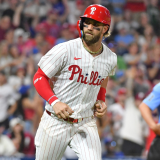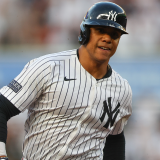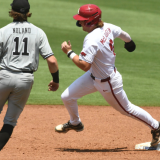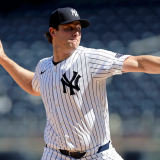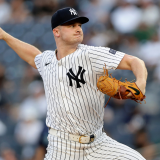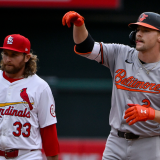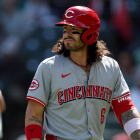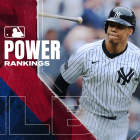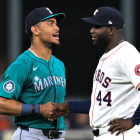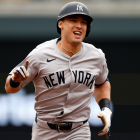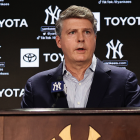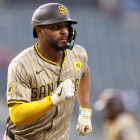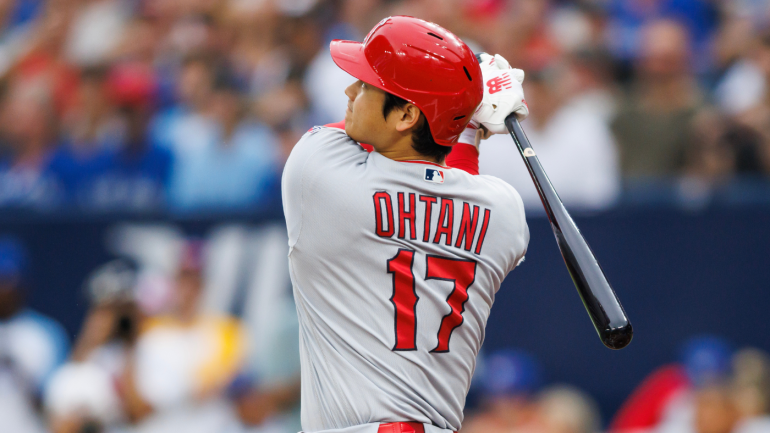
The singular Shohei Ohtani is the greatest and the most famous baseball player in the world, and that's why he just recently put ink to paper on the largest contract in MLB history, all to the lasting uplift of the Dodgers. All of that is the case because of his unexampled excellence at the plate and on the mound.
As you're aware, however, Ohtani will not pitch in 2024 for the Dodgers as he recovers from a September procedure to repair a UCL tear in his throwing elbow. That means that Ohtani in the upcoming season will be "just" a hitter for his new team.
The word just is given the soft mockery of quotation marks because Ohtani this past season proved himself as one of the very best hitters in all of baseball. Thanks to the skills-driven performance underlying his 2023 plate numbers, he figures to be just that for the foreseeable future – a batman on the short-short-list of the most productive in MLB. So to set the scene for his bat-only 2024 season in Los Angeles, let's take a look at the current version of Ohtani the hitter – what makes him great and why he'll probably keep it up for the foreseeable future.
First, let's appreciate what he did in 2023 with the bat. In 135 games as the Angels' DH, Ohtani authored a slash line of .304/.412/.654/ with an AL-leading 44 home runs and an MLB-leading 325 total bases. In terms of OPS+, which is OPS adjusted to reflect league conditions and home-ballpark effects, Ohtani's figure of 184 – which means his park-adjusted OPS was 84% better than the league-average – was tops among MLB qualifiers this past season. Ohtani's league lead in OPS+ was a fairly cavernous one, as Corey Seager of the Rangers notched the second-place figure of 170.
There's another, even more illuminating metric that we can turn to called weighted on-base average, or wOBA. wOBA assigns proper value to every possible offensive event that happens while a batter is at the plate. Those proper valuations of singles, doubles, homers, walks, etc., distinguish wOBA from more traditional measures like AVG, OBP, and SLG and provide a more accurate snapshot of a hitter's true value. Also, for simplicity wOBA is scaled to look like OBP, which means that, say, .400 is elite and .290 is pretty poor.
Ohtani last season led all comers with a wOBA of .433, which put him five points ahead of next man up and NL MVP Ronald Acuña Jr. That's also a career-high figure for Ohtani. Often when you see such a sky-scraping wOBA, it's in part driven by good fortune. In Ohtani's case, however, that really isn't the case. There's a related metric called expected wOBA, or xwOBA, that calculates a hitter's deserved wOBA based on quality of contact and so forth. In the case of Ohtani in 2023, he registered an xwOBA of .426 – basically a rounding error away from his actual wOBA.
This leads into an important reality moving forward for Ohtani the hitter – he reached new heights in 2023 when it comes to quality of contact. Consider the following:
- Ohtani from 2018 through 2022 had an average exit velocity off the bat of 92.6 mph, which is already elite (the MLB average is 88.4 mph). In 2023, however, Ohtani's average exit velo vaulted to 94.4 mph, which puts him in the 99th percentile among MLB hitters. Last season, just Aaron Judge and Acuña boasted higher average figures.
- When it comes to barrel rate, or a hitter's percentage of batted balls that leave the bat at the ideal combination of launch angle and exit velocity for power production, Ohtani's 2023 mark of 19.6% was in the 100th percentile. In other words, Ohtani's gaudy power numbers were very much earned.
- While Ohtani didn't notch a career-high in maximum exit velocity, his top-line figure of 118.6 mph this past season ranked in the top 1% of all batted balls. As we know, there's forward-looking value in even a single ball that leaves the bat with such force and speed.
Certainly not unrelated to all this devastation at the plate is Ohtani's mastery of what for hitters is a core and essential skill – handling fastballs. Over at MLB.com, David Adler undertook a more detailed look at what Ohtani did to hard stuff last season, and it's worth your time. The executive summary is that Ohtani has developed into one of and perhaps the best hitter in baseball against fastballs, fastballs thrown especially hard (95 mph or more), and fastballs in the upper segments of the strike zone (i.e., the kinds of fastballs that typically get whiffs). Not only is he doing much greater damage against such pitches, but he's also striking out less against them.
For some further context, Ohtani this past season against fastballs at 95 mph placed in the upper third of the strike zone – the ideal pitcher's fastball – batted .360/.467/.480. The league as a whole against such fastballs batted just .181/294/.311 against such offerings.
Speaking of Ohtani's elite batted-ball authority, he really took a step forward on this front during the 2021 season. That's no accident, as elbow and knee injuries compromised him at the plate earlier in his career. As well, prior to that 2021 season he undertook a more rigorous strength-training program and better tailored his diet toward his specific performance needs. Evidence suggests that those efforts – plus a healthier lower half – yielded the desired results (and then some).
Playing a supporting role in all that devastation off the bat is Ohtani's patience at the plate, which allows him to run high on-base percentages. He tends to make the most of those walks given his above-average speed and knack for taking the extra base at an above-average clip.
Predictably, this leaves the opposing moundsman with nowhere to attack Ohtani in the zone and almost nowhere to attack anywhere near the zone. Take a look at his 2023 wOBA breakdown by pitch location:
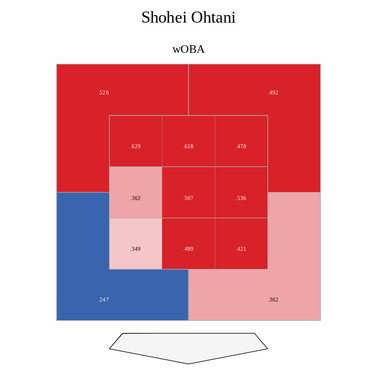
The search for a hole in his swing will go on, as it does for every great hitter, but right now there's no evidence of one.
As for the elbow injury and subsequent surgical procedure that will keep him off the mound in 2024, there's no real concern that it will affect his performance as a hitter in the upcoming season. Ohtani suffered the UCL tear – or at least the culmination of it – while pitching against the Reds in the first game of an Aug. 23 doubleheader. From that day forward until an oblique strain ended his season on Sept. 4, Ohtani slashed .306/.490/.583. As well, that aforementioned peak exit velo of 118.6 came on Aug. 29 in the form of a (very) ringing double off Philly's Andrew Bellatti. Ohtani is of course clear of surgery and by the time spring training comes around, he'll be fully healed and then some insofar as hitting is concerned. Throw in the fact that Ohtani in 2024 won't be a player of divided attentions thanks to his absence from the mound – and also won't be subject to the fatiguing effects of pitching – and there's every reason to believe he'll again be foremost in the discussion for best hitter in baseball.
Good enough to win a third MVP award? A primary DH has never won the award. Coming the closest was Don Baylor in 1979 – coincidentally as a member of the Angels. En route to winning the hardware, he made 65 starts at DH but the rest at the outfield corners. Given that Ohtani put up 6.0 WAR in 135 games as a DH this past season, he can make a plausible case for himself if he plays something close to a full year and puts up 2023-grade numbers. He's also, of course, no stranger to doing baseball things that have never been done before.
However all of that plays out, the more important reality is that Ohtani the Hitter in 2024 will very likely continue being what he was in 2023 – one of the very best producers of all.







